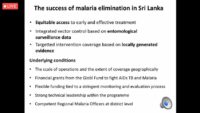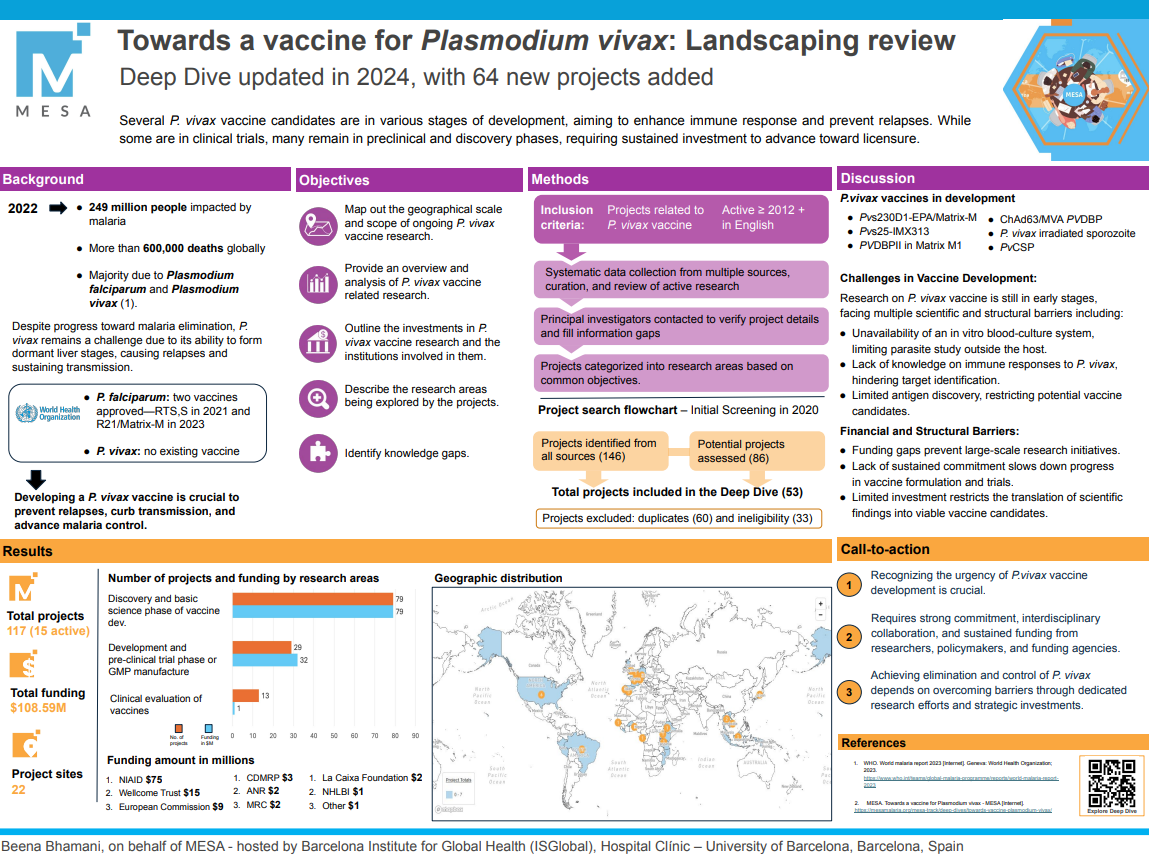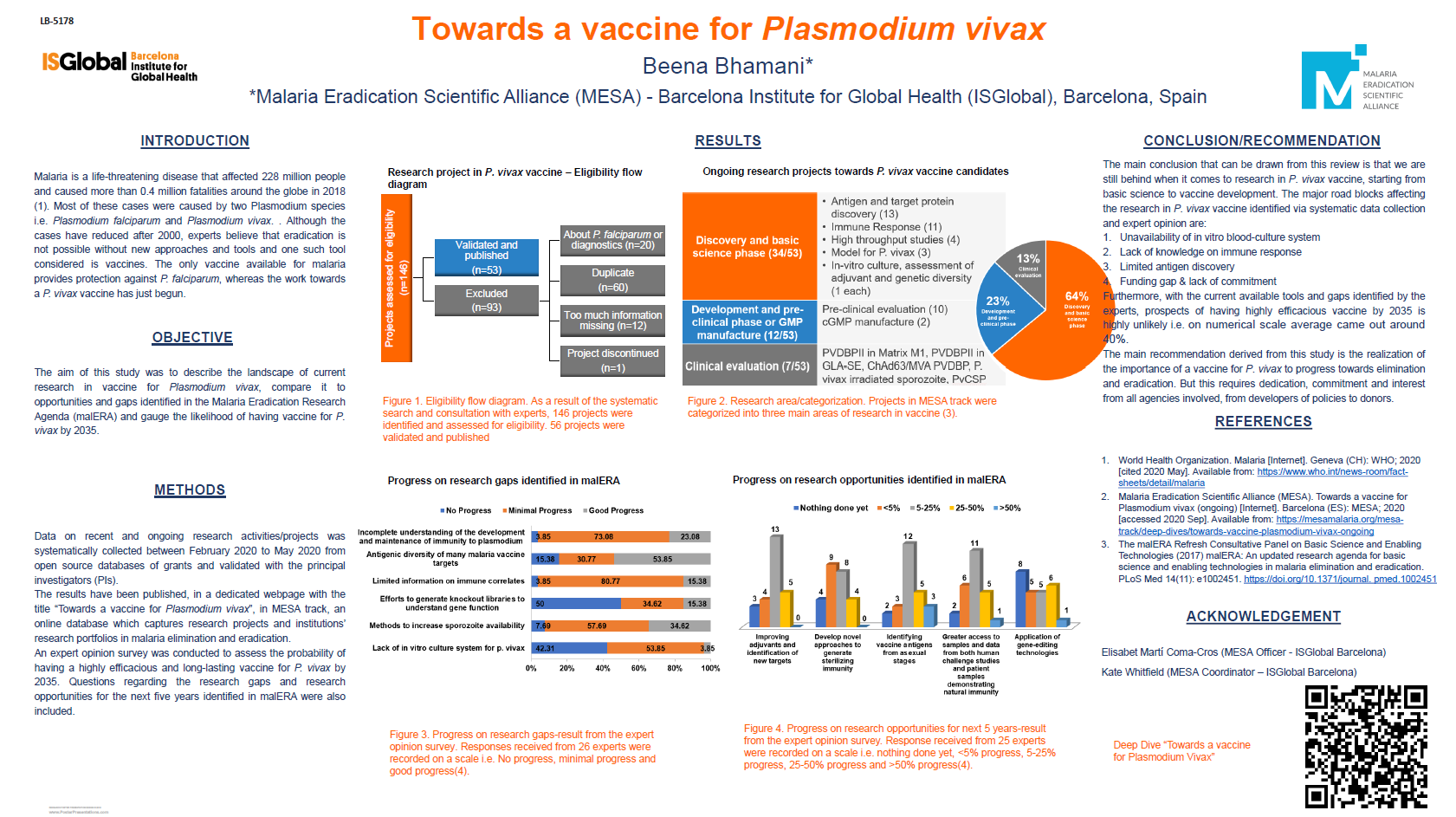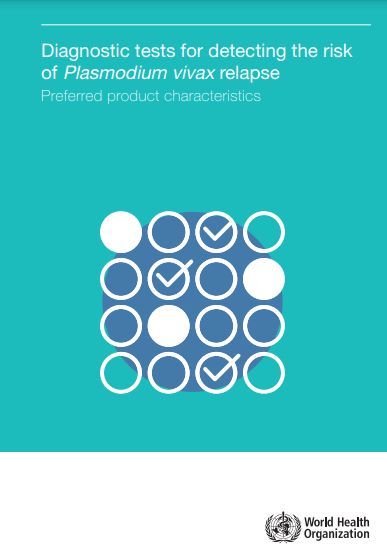8th Virtual International Conference on Plasmodium vivax Research (ICPvR) – 2022: Day 4
Friday, 8th April 2022
Published: 09/04/2022
This report is brought to you by the MESA Correspondents Melina Florez-Cuadros, Varun Gorki, Neha Sylvia Walter, and Duru Vincent Chiagozie. Senior editorial support has been facilitated by the Organizers and Chairs of the sessions.
THEMES: THEMES: Basic Science | Epidemiology | Health Systems | P. vivax
MESA Correspondents bring you cutting-edge coverage from the virtual 8th International Conference on Plasmodium vivax Research (ICPvR 2022)
Day 4: Friday, 8th April 2022
Session 7: Transmission – from gametocyte biology to transmission studies and entomological surveillance
Fitsum Girma Tadesse (Armaeur Hansen Research Institute, Ethiopia) presented his talk on the Plasmodium vivax and Anopheles stephensi in the Horn of Africa. He described this region as an epicenter of emerging challenges for example Pfhrp2/3 deletion, artemisinin resistance and An. stephensi emergence in urban settings, which is a dominant vector in India and Persian Gulf. This new scenario for An. stephensi threatens 126 million people living in urban areas in Africa, moreover this vector is resistant to insecticides and very efficient in transmission of both P. vivax and P. falciparum. He estimated an elevation in malaria incidence even in low transmission areas post An. stephensi invasion. He also explained the changing parasite dynamics in urban areas Ethiopia, Djibouti and Sudan with a high proportion of P. vivax malaria infections.
Rajnikant Dixit (Indian Council of Medical Research and National Institute of Malaria Research – ICMR/NIMR, India) presented his talk on the interactions between mosquito gut- microbiome and the development of Plasmodium vivax. He illustrated that the vector competency of a mosquito is modulated by its gut microbiota. Gut-meta-transcriptomic study revealed the vector immune evasion by the parasite during its invasion phase by suppressing microbiota. Further, RNAseq analysis highlighted the genetic changes in the parasite enabling it to manipulate mosquito’s metabolism for its own survival and transmission.
Wang Nguitragool (Mahidol University, Thailand) et al. wanted to understand how patients with low parasitemia contribute to P. vivax transmission, as well as the transmission capacity of mosquitoes under such circumstances. They performed serial dilutions of 8 patients’ samples for feeding membrane assays, to evaluate parasite density and mosquito infectivity counting the oocysts present in the gut. Infection rate and intensity were positively correlated with parasite density. Even though the study demonstrates the ability of P. vivax to infect mosquitoes at a very low parasitemia, there is a large variation among cases and no immunity was taken into account. Further analyses are needed.
Clara Champagne (Swiss Tropical and Public Health Institute, Switzerland) illustrated the role of mathematical transmission modelling to estimate the risk and impact of various malaria control interventions against P. vivax. The model can further be used to compare strategies for disease elimination. She introduced a model for P. vivax dynamics, which also included interventions for case management. She also presented the applications of the model in Panama to identify sustained areas of transmission and an R package available online, which can be used to apply the model to data. To conclude, she pinpointed certain limitations of the model viz. simplified model for treatment delays and valid for low transmission areas where immunity does not play a major role.
Session 8: Genomic epidemiology and parasite evolution
Ian Cheeseman (Texas Biomedical Research Institute, San Antonio, United States) aimed to develop a single-cell genomics approach to understand how malaria parasites adapt to new environments. Cheeseman conducted a single-cell sequencing of recurrent P. vivax primary and secondary infection from patients from Thailand and identified de novo mutations (DNMs) in the P. vivax malaria isolates. More than half of the identified DNMs were tight clusters suggesting a cryptic relatedness. Results showed no correlation between the mutations and the formation of the hypnozoite stage. Also that DNMs were under a strong positive selection and they had functional relevance with recurrent mutations in the ApiAP2 gene family. He compared this result with another P. falciparum infection from patients from Malawi and found some parallel targets of mutation in both species. Cheeseman’s study reveals information on relatedness and process of adaptation in malaria infection.
Johanna Helena Kattenberg (Institute of Tropical Medicine Antwerp, Belgium) started her talk by noting that molecular tools were important in characterizing changing transmission intensity and were also able to guide malaria control by distinguishing local and imported cases and also sources of reintroduction. She designed novel within-country single nucleotide polymorphism (SNP) barcodes for Vietnam and Peru using whole genome data. SNPs were selected and genotyped using a highly multiplexed P. vivax Ampliseq NGS assay including amplicons targeting some drug resistance genes. These were applied to sample isolates from travellers to routine samples collected at local sentinel sites in Vietnam and to retrospective samples from Peru. Kattenberg’s study highlighted higher diversity and increased resolution for within-country spatio-temporal surveillance.
Lucas Buyon (Harvard TH Chan School of Public Health, United States) summarized that owing to the lack of P. vivax culture, the molecular determinants of chloroquine and other antimalarials resistant to P. vivax are uncertain. pvmdr1, an orthologous to pfmdr1, reflected both polymorphisms in sequence and expression level. Notwithstanding decades of work into pvmdr1, no conclusive link has been found between pvmdr1 polymorphisms and drug resistance. To elucidate that, they analyzed 24 pvmdr1 haplotypes alleles and an endogenous pkmdr1 gene was replaced with pvmdr1 alleles in P. knowlesi transgenic lines were then tested for resistance to a variety of antimalarial drugs and found certain haplotypes resistant to mefloquine, dihydroartemisinin, and lumefantrine. Furthermore, they had no evidence that pvmdr1 haplotypes alone confer a substantial shift in chloroquine susceptibility.
Mariana Kleinecke (Menzies School of Health Research and Charles Darwin University, Australia) described that the information for a genome-wide panel of microhaplotypes can be obtained from amplicon-based sequencing assays whose additional analyses and improvements are being made, by eliminating superfluous markers to get a final panel of 100 microhaplotypes. In brief, a single Illumina rhAmpSeq multiplex was designed and they took the 192 P. vivax samples (10 countries) with 16 control samples to conduct the Multiplex and indexing PCRs. To inform performance of these potential assays, a MiSeq run was conducted and analysed with a standard pipeline consisting of bwa, samtools, picard and GATK. A majority of the assays performed well with samples from 10 countries, and Plasmodium species were reliably distinguished using mitochondrial markers. Globally, population genetic investigations revealed a high level of diversity, as well as a geographic grouping.
Rapid Fire Presentation – Transmission – from gametocyte biology to transmission studies and entomological surveillance
#400 Lincoln Timinao (PNG Institute of Medical Research, Papua New Guinea) performed direct skin feeding assays on 11 asymptomatic Plasmodium carriers in Madang Province and also on clinical samples and found P. vivax to be more infectious in both the populations and that asymptomatic individuals can still transmit malaria.
#401 Camila Fabbri (Fiocruz, Brazil) assessed asexual and sexual stage maturation exposed to methylene blue, using three different. Methylene blue inhibited schizonts with a lower IC50 than chloroquine also inhibited the ookinetes and even though it didn’t decrease the infection rate in direct feeding it reduced the oocyst intensity.
#402 Wakweya chali Gerba (Armauer Hansen Research Institute, Ethiopia) 241 P. vivax patients were recruited for blood collection and follow-up. Results show that 84 patients had a recurrence episode during the study. In addition, 45% of mosquitoes fed with infectious blood were infected.
#403 Sofia Forcellini (Instituto Carlos Chagas/ Fiocruz, Brazil) studied the antigenicity of the Plasmodium vivax gametocyte protein Pvs47. 30% of 40 plasma samples showed IgG againts Pvs47. Naturally acquired antibodies recognize the recombinant protein Pvs47.
#404 Lorena Tapia (Naval Medical Research Unit Nº6, Perú) and her group tested three P. vivax adapted strain lines to recreate the life cycle in vivo. After unsuccessful attempts to reach blood stage infection, they inoculated all three strains in one splenectomized monkey in hope to obtain hybrids with increased fitness. Infection was a success and three more monkeys were infected through a mosquito bite. Whole genome sequencing is under way.
Rapid Fire Presentation – Genomic epidemiology and parasite evolution
#405 Alebachew Messele Kebede (Aklilu Lemma Institute of Pathobiology, Addis Ababa University, Ethiopia) conducted an in-depth genomic analysis of Ethiopian P. vivax genomes. This highlighted adaptations of potential public health concerns in a setting with moderately high and stable transmission of P. vivax malaria and underscored the need for enhanced P. vivax interventions and surveillance to identify and contain new adaptive variants that threaten control and elimination efforts.
#406 Jillian Grassia (Duke University, United States) leveraged a simulation model for P. vivax that incorporates realistic features of parasite life history and epidemiology as well as studies that expected genetic diversity of the parasite population. This model can be used to test the impact of intervention on parasite genetic diversity through simple adjustments to parameters.
#407 Alison Paolo Bareng (Deakin University, Australia) sought to determine the global distribution of antigen diversity and to identify gene regions with signatures of immune selection amongst leading P. vivax vaccine candidate antigens and sero-surveillance markers. The result from this study will guide researchers in designing widely effective vaccines and serological tools against P. vivax.
#408 Suman Tamang (Indian Council of Medical Research – ICMR and National Institute of Malaria Research – NIMR, India) highlighted the importance of molecular markers to confirm drug resistance and determine it trends. concluded in his presentation that isolates obtained from Goa exhibited mutant genotypes [Pvdhfr (80%) and Pvdhps (52%)] in P. vivax with novel k12 mutation in contrast to Delhi isolates [Pvdhfr (13%) and Pvdhps (0%)] which is an indicator of the emergence of sulfadoxine-pyrimethamine drugs resistance.
#409 Catarina Bourgard (University of Campinas, Brazil) illustrated the methodological outline made for RNA-seq from P. vivax isolates with better RNA extraction (yielding ~ 100 pg.µL−1), suitable for Illumina sequencing, SMART-Seq and Ultra-Low Input RNA library which would solve the problem of getting RNA from low parasitaemia and would have a favourable influence on P. vivax research.
#410 Noelia Coronado (Universidad Peruana Cayetano Heredia, Peru) pointed out that the genes encoding MSP8 and MSP10 of P. vivax have a lot of genetic diversity with no selection pressure. To reveal the impact of geographic origin of the parasite on diversity and potentially host antibody response, genetic analysis of more sequences should be done.
Richard Carter memorial lecture
Time bears witness to deeds undertaken with perseverance, especially those promoting peace and health for mankind. The Richard Carter Memorial Lecture was announced to commemorate malariologist Professor Richard Carter who contributed so much to the study of malaria and Plasmodium vivax and who died in September last year. Jane Carlton (New York University, United States) gave a summary of Dr. Carter’s life and work at the University of Edinburgh and the National Institutes of Health, U.S.A., describing his intellectual curiosity, passion for research, and keen mentorship of students, closing with thoughtful remarks from several of his colleagues. Kamini Mendis (University of Colombo, Sri Lanka), a long-time collaborator, presented the Richard Carter memorial lecture concerning malaria elimination in Sri Lanka between 2000 and 2015. Dr. Mendis highlighted that access to effective and early treatment, integrated vector management and targeted interventions based on the local evidence were the cornerstone for successfully eliminating malaria in Sri Lanka. The pre-elimination phase was initiated in 2008 and the number of cases gradually declined until the last case was reported in 2012 during a very well controlled outbreak in the south of the country. Sri Lanka received the WHO certification as malaria free in 2015. She quoted Dr. Richard Carter that as more interventions are targeted to control P. falciparum the residual P. vivax burden typically increases. She reviewed the features of P. vivax which give it a survival advantage and emphasized that preventing relapses, efficient diagnosis and vector control comprise an effective strategy to contain and eliminate P. vivax malaria. Dr. Mendis concluded that malaria can be eliminated even with the currently available tools, but that the strategies and interventions must accord to the reality of local areas, and that prompt action is required which should be targeted efficiently.
Closing Ceremony
The participants and scientists of the four-day event were thanked by the organizers Kamala Thiemer and Leanne Robinson for their participation and interaction with speakers after their presentations and during the spatial chat. The organizers warmly expressed gratitude to the MESA team and their correspondents for making this event available as a recording on the website. The winners of the best talk and poster awards were also announced with prizes. The organizers were pleased to confirm that the next ICPvR will be hosted in India.
This report is brought to you by the MESA Correspondents Melina Florez-Cuadros, Varun Gorki, Neha Sylvia Walter and Duru Vincent C. Senior editorial support has been facilitated by the Organizers and Chairs of the sessions.
Published: 09/04/2022
This report is brought to you by the MESA Correspondents Melina Florez-Cuadros, Varun Gorki, Neha Sylvia Walter, and Duru Vincent Chiagozie. Senior editorial support has been facilitated by the Organizers and Chairs of the sessions.
THEMES: Basic Science | Epidemiology | Health Systems | P. vivax





